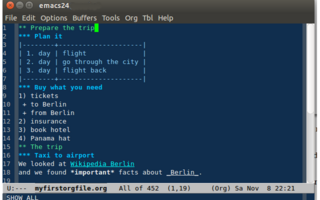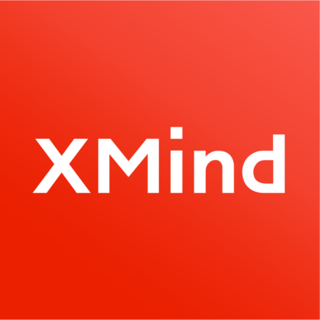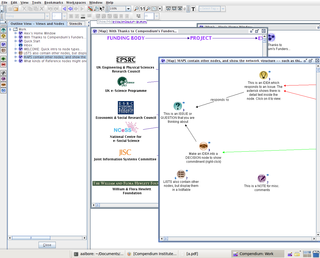Related Research Articles

Hypertext is text displayed on a computer display or other electronic devices with references (hyperlinks) to other text that the reader can immediately access. Hypertext documents are interconnected by hyperlinks, which are typically activated by a mouse click, keypress set, or screen touch. Apart from text, the term "hypertext" is also sometimes used to describe tables, images, and other presentational content formats with integrated hyperlinks. Hypertext is one of the key underlying concepts of the World Wide Web, where Web pages are often written in the Hypertext Markup Language (HTML). As implemented on the Web, hypertext enables the easy-to-use publication of information over the Internet.

A mind map is a diagram used to visually organize information into a hierarchy, showing relationships among pieces of the whole. It is often created around a single concept, drawn as an image in the center of a blank page, to which associated representations of ideas such as images, words and parts of words are added. Major ideas are connected directly to the central concept, and other ideas branch out from those major ideas.

An outliner is a specialized type of text editor used to create and edit outlines, which are text files which have a tree structure, for organization. Textual information is contained in discrete sections called "nodes", which are arranged according to their topic–subtopic (parent–child) relationships, like the members of a family tree. When loaded into an outliner, an outline may be collapsed or expanded to display as few or as many levels as desired.
Hypermedia, an extension of the term hypertext, is a nonlinear medium of information that includes graphics, audio, video, plain text and hyperlinks. This designation contrasts with the broader term multimedia, which may include non-interactive linear presentations as well as hypermedia. It is also related to the field of electronic literature. The term was first used in a 1965 article written by Ted Nelson.
The following outline is provided as an overview of and topical guide to software engineering:

FreeMind is a free mind mapping application written in Java, which is further developed by the fork Freeplane until today (2021). FreeMind itself was last updated in 2014. FreeMind is licensed under the GNU General Public License Version 2. It provides extensive export capabilities. It runs on Microsoft Windows, Linux, and macOS via the Java Runtime Environment.
A tinderbox is a container with the essential tools to make a fire.
Eastgate Systems is a publisher and software company headquartered in Watertown, Massachusetts, which publishes hypertext.

MindManager is a commercial mind mapping software application developed by Mindjet. The software provides ways for users to visualize information in mind maps and flowcharts. MindManager can be used to manage projects, organize information, and for brainstorming.

XMind is a mind mapping and brainstorming software, developed by XMind Ltd. In addition to the management elements, the software can be used to capture ideas, clarify thinking, manage complex information, and promote team collaboration. As of April 2013, XMind was selected as the most popular mind mapping software on Lifehacker.
A web browser is a software application for retrieving, presenting and traversing information resources on the World Wide Web. It further provides for the capture or input of information which may be returned to the presenting system, then stored or processed as necessary. The method of accessing a particular page or content is achieved by entering its address, known as a Uniform Resource Identifier or URI. This may be a web page, image, video, or other piece of content. Hyperlinks present in resources enable users easily to navigate their browsers to related resources. A web browser can also be defined as an application software or program designed to enable users to access, retrieve and view documents and other resources on the Internet.
TheBrain, formerly branded PersonalBrain, is a mind mapping and personal knowledge base software from TheBrain Technologies. It uses a dynamic graphical interface that maps hierarchical and network relationships. It includes the ability to add links to Web pages and files as well as notes and events using a built-in calendar. It is cross-platform, available for Windows, Unix and Unix-like operating systems, and Mac OS X. It is available in a free edition as well as in commercial editions with additional features.

Mindjet is a mind mapping and innovation management software company headquartered in San Francisco, California. Mindjet's software products, including its flagship product MindManager and SpigitEngage, are designed to visually and collaboratively manage information and tasks. As of June 2016, Mindjet had approximately sixteen million users.

Mindomo is a versatile freemium collaborative mind mapping, concept mapping and outlining tool developed by Expert Software Applications. It can be used to develop ideas and interactively brainstorm, with features including sharing, collaboration, task management, presentation and interactive web publication.

Compendium is a computer program and social science tool that facilitates the mapping and management of ideas and arguments. The software provides a visual environment that allows people to structure and record collaboration as they discuss and work through "wicked problems".

Hypertext is text displayed on a computer or other electronic device with references (hyperlinks) to other text that the reader can immediately access, usually by a mouse click or keypress sequence. Early conceptions of hypertext defined it as text that could be connected by a linking system to a range of other documents that were stored outside that text. In 1934 Belgian bibliographer, Paul Otlet, developed a blueprint for links that telescoped out from hypertext electrically to allow readers to access documents, books, photographs, and so on, stored anywhere in the world.
ConceptDraw OFFICE is a proprietary office software suite of business productivity tools, developed by Computer Systems Odessa for use with either Microsoft Windows and macOS operating systems. ConceptDraw OFFICE is composed of mind mapping, project management and business diagramming tools. The three components use the cross-format exchange technology, allowing users to employ a visual approach to information management whereby the same set of data can be shown as a mind map, Gantt chart, or business graphic design.

ConceptDraw MINDMAP is proprietary mind mapping and brainstorming software developed by CS Odessa for Microsoft Windows and Apple macOS operating systems.

A personal knowledge base (PKB) is an electronic tool used to express, capture, and later retrieve the personal knowledge of an individual. It differs from a traditional database in that it contains subjective material particular to the owner, that others may not agree with nor care about. Importantly, a PKB consists primarily of knowledge, rather than information; in other words, it is not a collection of documents or other sources an individual has encountered, but rather an expression of the distilled knowledge the owner has extracted from those sources.
References
- ↑ Minifinders: Multimedia to Organization Software, MacWorld, May 18, 2004. Archived May 28, 2005, at the Wayback Machine
- ↑ Interesting Software Update: Tinderbox How-To, Jerry’s Brain - James Fallows The Atlantic, 9 March 2015
- ↑ Tinderbox 1.2: multipurpose app sparks, stores, and shares ideas., MacWorld, September 1, 2003. Archived May 16, 2011, at the Wayback Machine
- ↑ Hurrah For Great Mac Software by Jeremy Wagstaff, The Wall Street Journal, October 16, 2003.
- ↑ Eastgate Tinderbox product page, August 16, 2007
- ↑ Flint
- ↑ Mark Bernstein, "Composites, Construction, Hypertext", Proceedings of the fourteenth ACM conference on Hypertext and hypermedia, ACM, New York, 2001. pp. 122-123.
- ↑ See the Tinderbox manual
- ↑ Notes about Notes and Tinderbox Prototypes
- ↑ Plotting With Tinderbox. YouTube . Archived from the original on 2021-12-11.